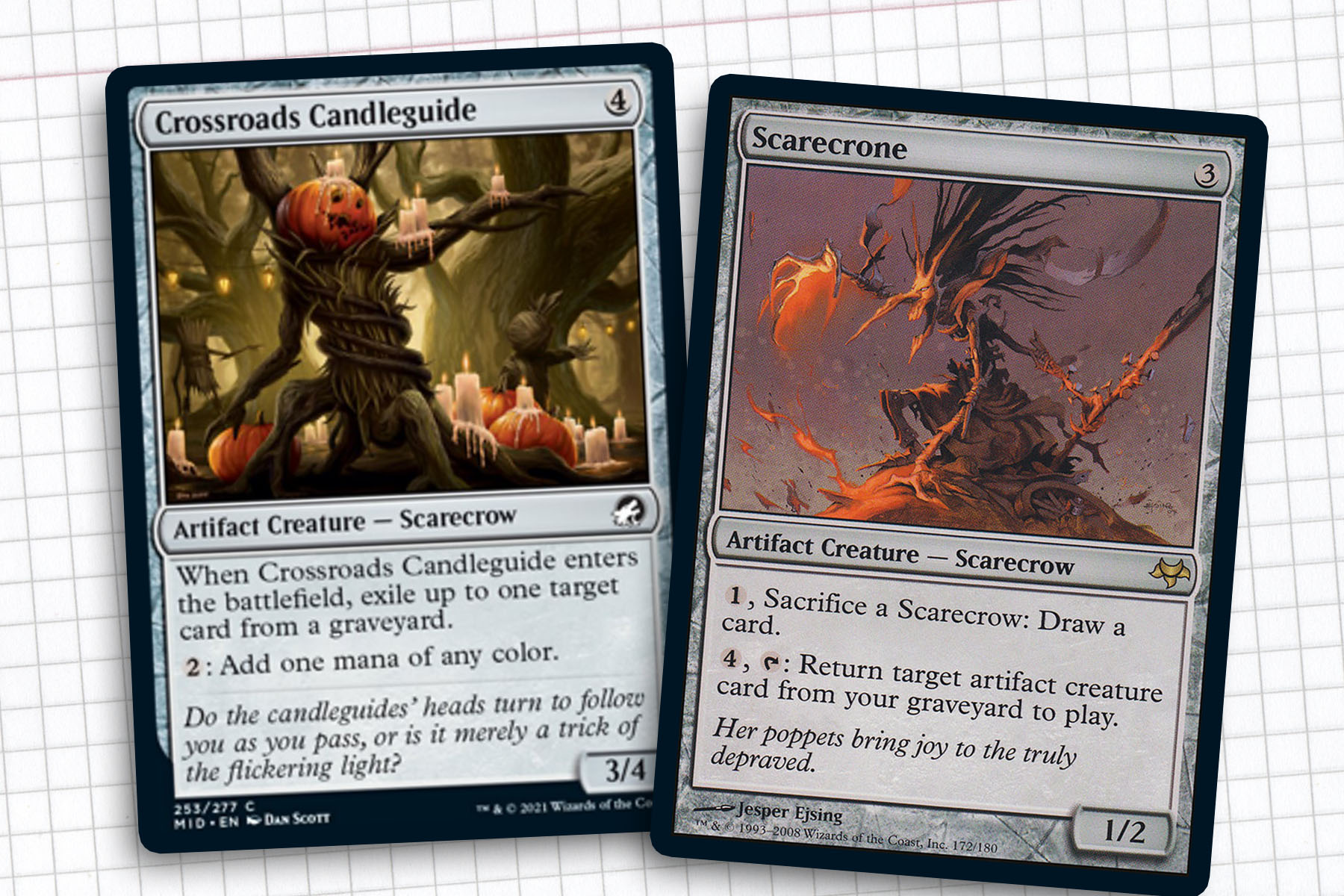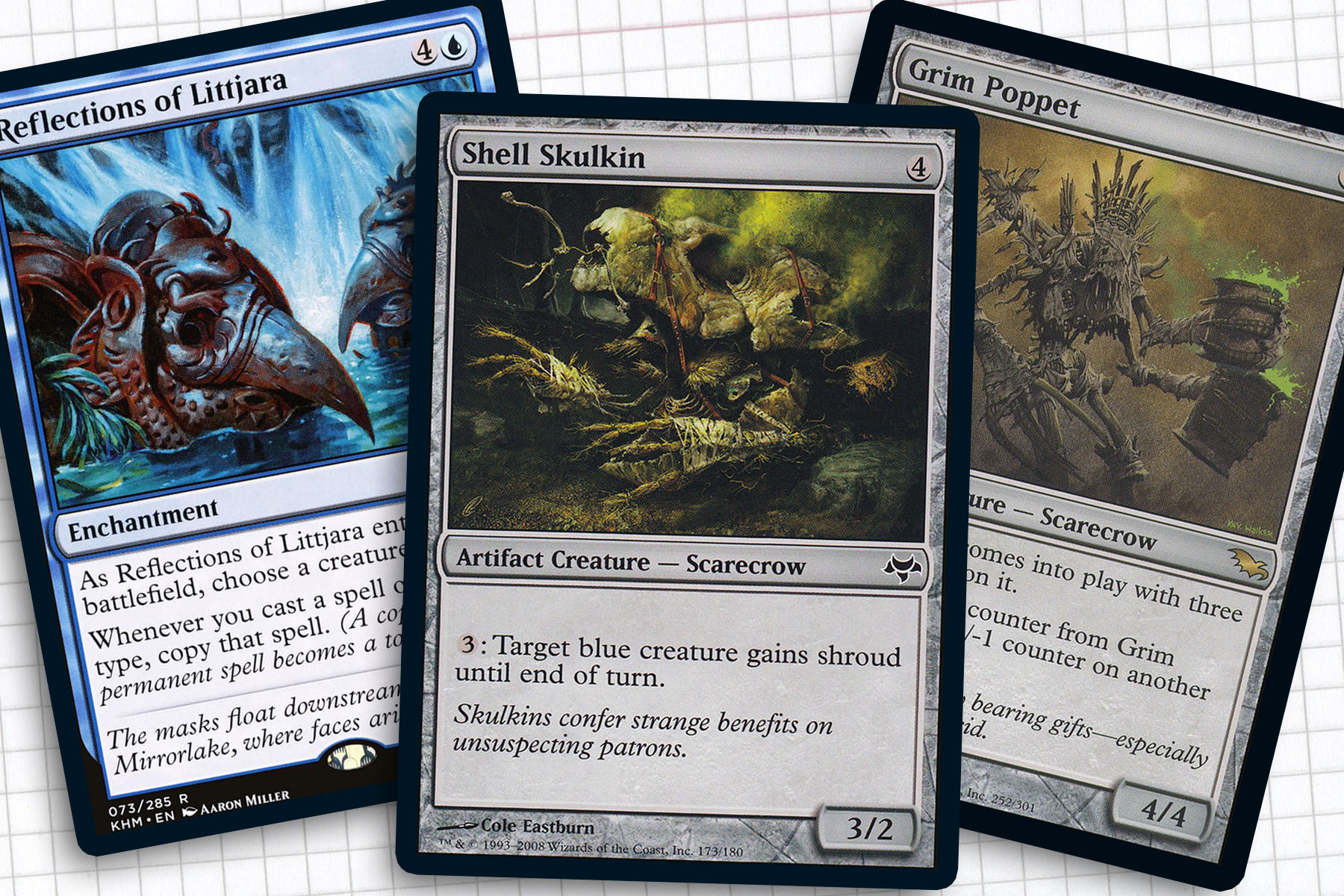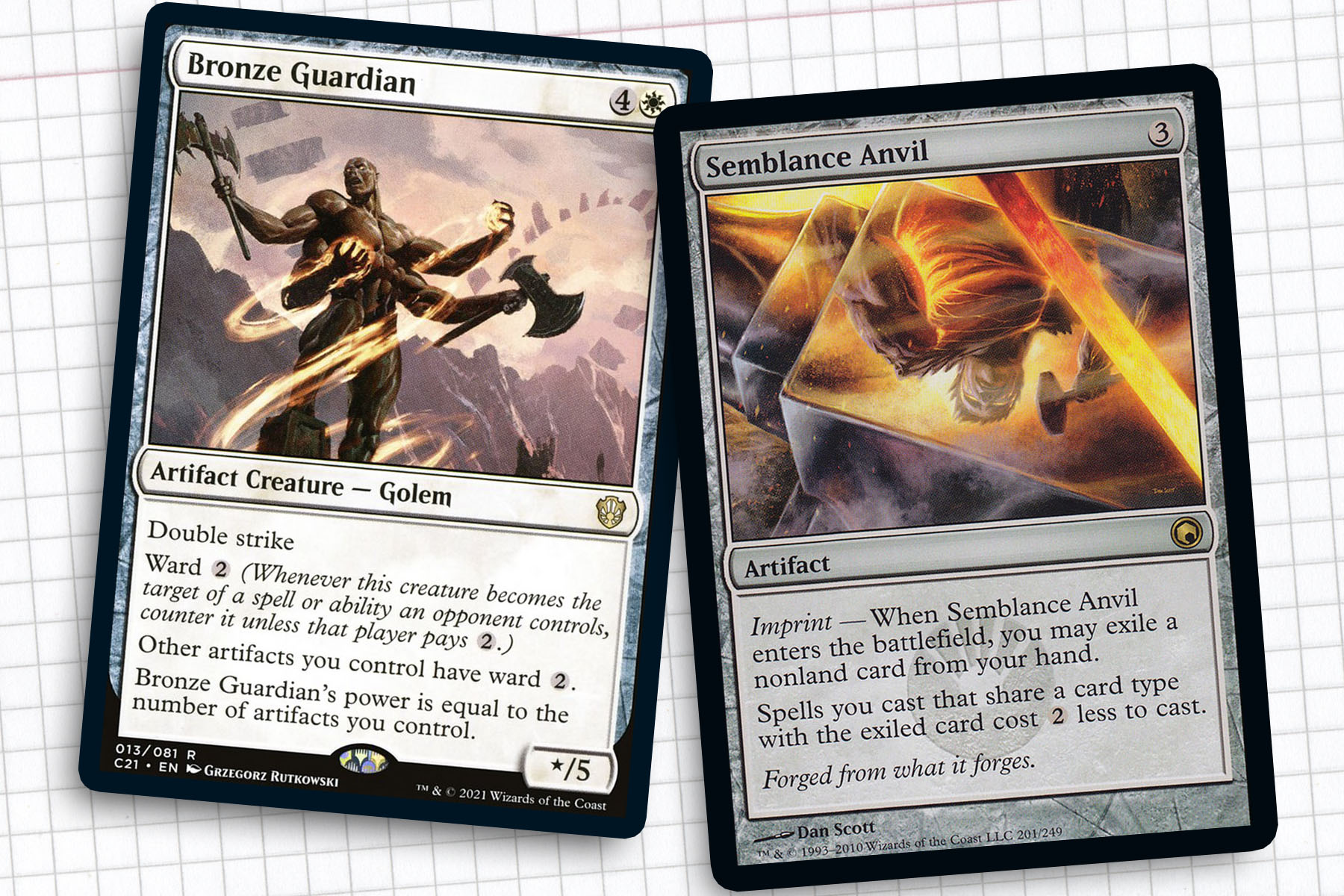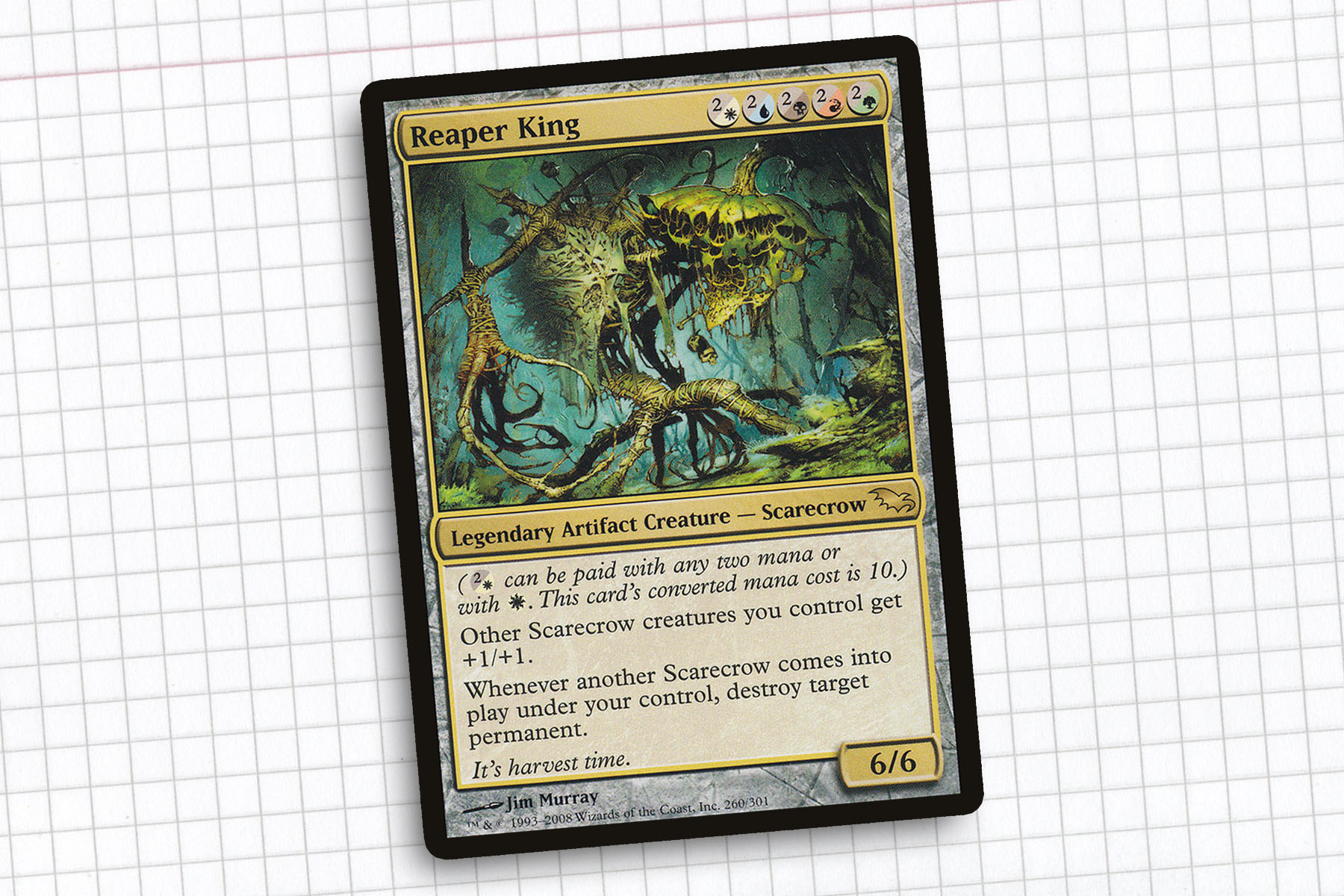We have reached the height of Spooky Season, when any self-respecting content creator is bound to cover the topics of ghosts, werewolves, and other scary creatures. I had already spoken about spirits in my deck tech for Quintorius, Field Historian earlier this year, and I covered my love for werewolves in my last article—so I thought it would be fitting to take a look at an underappreciated scary tribe: the scarecrows of Magic.
This deck has been on my mind for the better part of the last five years, constantly on the edge of being built but never finding its voice. The power to destroy any permanent is a strong one, and this week we will be piloting a deck that is high on removal but low on conventional win conditions. A five color deck that has direction but is far from the typical deck. We have some unconventional fun in our future!
Commander: Reaper King
Creatures: Adaptive Automaton, Antler Skulkin, Amoeboid Changeling, Arcbound Shikari, Archetype of Endurance, Archetype of Finality, Blazethorn Scarecrow, Brass Herald, Bronze Guardian, Chameleon Colossus, Changeling Titan, Crossroads Candleguide, Graveshifter, Grim Poppet, Heap Doll, Impostor of the Sixth Pride, Irregular Cohort, Jawbone Skulkin, Jousting Dummy, Masked Vandal, One-Eyed Scarecrow, Scarecrone, Scaretiller, Scorn Effigy, Scuttlemutt, Shell Skulkin, Storvald, Frost Giant Jarl, Tatterkite, Universal Automaton, Unsettled Mariner, Wild-Field Scarecrow
Artifacts: Azorius Signet, Blade of Selves, Commander’s Sphere, Conjurer’s Closet, Firemind Vessel, Gilded Lotus, Inspiring Statuary, Lightning Greaves, Mimic Vat, Mirrorworks, Obelisk of Urd, Prototype Portal, Semblance Anvil, Simic Signet, Skyclave Relic, Sol Ring, Swiftfoot Boots, Vanquisher’s Banner, Wayfarer’s Bauble
Enchantments: Arcane Adaptation, Cover of Darkness, Kindred Discovery, Reflections of Littjara
Instants: Kindred Summons
Sorceries: Crippling Fear, Distant Melody, Kindred Charge, Merciless Eviction, Rite of Replication, Saheeli’s Artistry, Wake the Past
Lands: Bloodstained Mire, Breeding Pool, Canyon Slough, Clifftop Retreat, Command Tower, Dragonskull Summit, Drowned Catacomb, Exotic Orchard, Fetid Pools, Flooded Strand, Forest, Gavony Township, Glacial Fortress, Godless Shrine, Hinterland Harbor, Irrigated Farmland, Island, Isolated Chapel, Mountain, Overgrown Tomb, Path of Ancestry, Plains, Polluted Delta, Power Depot, Rootbound Crag, Sacred Foundry, Scattered Groves, Sheltered Thicket, Steam Vents, Sulfur Falls, Sunpetal Grove, Swamp, The World Tree, Treasure Vault, Windswept Heath, Wooded Foothills, Woodland Cemetery

The Draw of the Scarecrows
Scarecrows date all the way back to The Dark, being seen once more in Portal Three Kingdoms, before a hiatus that lasted until Shadowmoor. Since first laying eyes on Reaper King, the scarecrow tribe has received a disproportionate amount of attention from me for the size and support it gets. What has stuck with me so much over the last ten years is the unconventional way that the tribe is treated and the way this general allows for a very open-ended design with its removal package covered. To be entirely honest, getting removal into my deck is certainly a blindspot I develop while drawing most lists, so not having to worry about this go around was quite a relief.
In constructing this deck, I took a lot of cues from Breya, Etherium Shaper and my own experience building around the eldrazi. I don’t intend to lean into the colorless nature of most scarecrows, since our general is itself a five-color creature and we rely so heavily on them. Drawing up my game plan, I want to swarm the board with as many creatures as I can and hopefully the army I’m creating will also inconvenience my opponents and prevent them from stopping me. Taking advantage of token shenanigans and a few blink effects means that we should be able to keep the board in check.

A Few Tribal Favorites
I don’t know what it is that draws me to unconventional tribes so often, the eldrazi being the best previous example. In that deck, I had a lot of fun diving into the small, non-titan eldrazi as the focus of my deck, which was built to be weird. With the scarecrows, we have a swath of creatures that don’t strictly stick to a theme except mostly being artifact creatures. But when our general is in play, they all become a bit more potent.
Right off the bat, I wanted to examine the cycle of Skulkin, which each grant bonuses to specific colored creatures. For this deck, I see Antler Skulkin, Jawbone Skulkin, and Shell Skulkin as most useful. These three will be protecting our general or creatures like Arcbound Shikari, Bronze Guardian, and Irregular Cohort; gaining additional triggers or keeping the rest of our battlefield protected. Expanding our view of the tribe, we also have Grim Poppet, who can pick off small creatures or one big creature; One-Eyed Scarecrow, lessening the effectiveness of opponents going wide; and Wild-Field Scarecrow, who can fix our mana after blocking.
To prop up our unconventional tribe, we have the same crop of power tribal support most decks do. But since we’re in all five colors, we don’t need to make compromises. Kindred Discovery and Kindred Summons are two of my favorite spells to have in a Commander deck; here they do a lot of heavy lifting giving our scarecrow spells card draw and the ability to explode onto the battlefield at a moment’s notice. Combined with Reaper King, each on-theme creature hits hard.
To help make all of our creatures relevant, Arcane Adaptation finds its place in the deck and Reflections of Littjara does silly things in coordination with the rest of our payoff spells. The most important part of playing with an underappreciated tribe is that they bring a bit of a rogue deck quality to the table; players will not know exactly to make of our deck and may not have the correct answers at the ready.

Making Artifacts Matter
With such a high saturation of 38 artifacts in total, it should be unsurprising that we will be leveraging artifacts-matter spells throughout the deck. Mirrorworks and Prototype Portal may not work well together, but they create the basis for multiple triggers from our general off our scarecrows. The tribe itself was already using Reaper King to make the sum greater than the parts, but if we can have multiple Adaptive Automatons or Grim Poppets in play, things can only go up from there.
Having multiple Semblance Anvils is also notable, because we then are not beholden to strictly lowering the cost of our artifacts, making our Merciless Eviction, Rite of Replication, or Wake the Past cheaper by imprinting the Distant Melody we may no longer need. Then we have the aforementioned Arcbound Shikari and Bronze Guardian, two cards that I think really bring the deck together by bolstering and protecting our creatures.
The only residual concern that we have is that artifacts are obviously a very fragile card type. And that like any deck that relies so heavily on creatures, we will lose momentum against any sort of mass removal. I would like to hope that I have been able to circumvent that weakness a little bit by swarming the board rather quickly. But we do have things like Wake the Past to get our creatures back. In the event that our battlefield gets wiped, we do have Mimic Vat to bring back our most desirable creature. Hopefully, with these pieces, we can persevere.
Building by the Books
Looking over this list, I don’t really feel like I wandered too far away from the average deck list for Reaper King. And I think, to some extent, that’s okay. With a tribe that is limited as much as scarecrows are, it’s hard to create an immense amount of originality—especially when the general needs you to invest heavily in that tribe. While I am an advocate for putting your heart and soul into the decks that mean the most to you, I think we need to divorce ourselves as a community from the idea that experienced players build entirely unique decks. Constructing a deck that is 90% solved, 10% your own thing is okay.
The reason why certain cards are popular in certain archetypes is because they work. And to try to go against the grain just because you want against the grain is going to result in a deck that doesn’t work or flow the way that you want, you’re going to find yourself falling behind in games and probably blaming the wrong elements of the game for your dissatisfaction.
Reaper King is an old school general that I really hope that more players can have the opportunity to pick up and play with. I would like to see more support for scarecrow the future, so that a Reaper King deck can come in a myriad of different flavors. Lord knows, we’ve seen enough support for humans.
For the next few weeks, I plan to explore my love of Kamigawa, leading into Neon Dynasty in the Spring. Hopefully you all will join me on that journey. Thanks for reading.
Ryan Sainio is a Graphic Designer who writes about EDH and the EDH community. He has been playing Magic: the Gathering since 7th Edition in 2002 and values flavorful and fun gameplay over competitively optimized decks.


